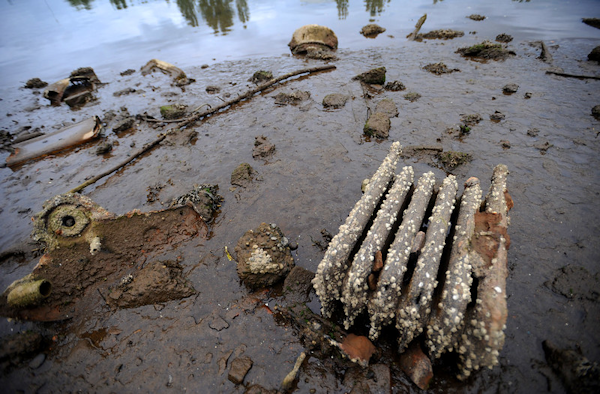SEJournal Online is the digital news magazine of the Society of Environmental Journalists. Learn more about SEJournal Online, including submission, subscription and advertising information.
 |
| The Toxic Substances Control Act regulates what chemicals are allowed into commerce. Above, a rusty radiator among other debris along the Duwamish River in Seattle, Wash., where sediments contain a wide range of pollution from years of industrial activity, including PCBs and mercury. Photo: U.S. EPA. Click to enlarge. |
Reporter’s Toolbox: EPA TSCA Database Back on the Street
By Joseph A. Davis
It was scandalous when a major U.S. Environmental Protection Agency chemical database vanished during the Trump administration. So it is news that ChemView has reappeared. The EPA announced it Feb. 3 (subscription required).
We will not get deeply into the scandal, which involved charges that industry and the EPA were colluding in secret to censor information on the health effects of new chemicals.
From the geeky perspective of environmental data journalism, however, we can celebrate the data’s return to being online.
The job now is to report on the health effects of chemicals. And the database, called ChemView, can really help even non-geeky journalists.
Tracking toxic chemicals
The nation’s main chemical safety law is the Toxic Substances Control Act, or TSCA. It was originally passed in 1976, and for many reasons it never worked very well.
Thus, it was a big deal when in 2016, after years of conflict, Congress passed a bill (named after the late Sen. Frank Lautenberg) that tried to make TSCA work again. It was a compromise, it wasn’t perfect, but it made regulation of chemical safety, especially for new chemicals, possible again.
Other laws, such as the Clean Water Act and the Clean Air Act, regulate direct pollution discharges. But toxic chemicals don’t all go out a drainpipe or up a smokestack. The special job of TSCA is to regulate what chemicals are allowed into commerce in the first place.
Once a chemical is introduced into products that are circulated in the economy, it can get into the environment. Once there, it can harm people’s health or even be fatal. It can cause cancer, endocrine disorders, neurological diseases, birth defects, lung problems and other harms. And once they are released into nature, they can kill wildlife and harm ecosystems.
TSCA regulates chemicals that have been used for a long time differently than it does new chemicals just being introduced into commerce.
What was new about the 2016 TSCA
revision was that for the first time
it required approval of new chemicals.
What was new about the 2016 TSCA revision was that for the first time it required approval of new chemicals. That approval depended on the submission of studies on how they affected health and the environment. The EPA looks at chemicals already in use on a different schedule.
How to use the data smartly
The ChemView database keeps track of the health and environmental studies of TSCA chemicals. You can access it here (view the EPA video tutorial here). It is online and searchable.
There are plenty of other EPA chemical databases, and we have reported on them here. But this one is especially good at tracking TSCA regulatory status.
Unlike some EPA databases, it is fairly easy to use, even for nonspecialists. It allows the searcher to ask sophisticated questions, and — we’ve got to say it — it works pretty well. Not all do.
ChemView even allows you to download your results. It is very well documented; you can find an introductory overview here. There is even a telephone helpline.
The ChemView database contains information about roughly 17,500 chemicals — which is a lot — but is not close to the number of all chemicals in commerce. The EPA is frank about the fact that it is still being built out.
One feature of ChemView that aids sophisticated searches is that you can restrict the search to one of many specific chemical lists used by the EPA in various programs.
For example, the lists include the Toxics Release Inventory, pesticide chemicals, Clean Water Act priority pollutants and chemicals of occupational safety and health concerns. Or you can select for specific chemical uses, such as bleaching agents, antimicrobials, dyes or children’s products.
Chemists will be pleased with ChemView’s ability to search on chemical identifiers. You can search for parts of a chemical name, or for chemical synonyms.
In recent (Trump) years, ChemView has been starved for funding. The EPA’s funding problems have not yet been fully fixed. But as ChemView develops in future years, reporters on chemical toxicity and the regulation thereof will want to bookmark it and add it to their toolbox.
[Editor’s Note: For more on reporting about toxic chemicals, see recent SEJournal stories on hotspot mapping, software to cover chemical disasters, the EPA’s CompTox chemicals dashboard, how to use cancer registries and on the Toxics Release Inventory (more on that). In addition, read columns on widening public information about chemical hazards and how the EPA is moving toward data openness. Plus, track headlines on chemicals in the news with EJToday on SEJ.org or via @EJTodayNews on Twitter.]
Joseph A. Davis is a freelance writer/editor in Washington, D.C. who has been writing about the environment since 1976. He writes SEJournal Online's TipSheet, Reporter's Toolbox and Issue Backgrounder, and curates SEJ's weekday news headlines service EJToday and @EJTodayNews. Davis also directs SEJ's Freedom of Information Project and writes the WatchDog opinion column.
* From the weekly news magazine SEJournal Online, Vol. 7, No. 6. Content from each new issue of SEJournal Online is available to the public via the SEJournal Online main page. Subscribe to the e-newsletter here. And see past issues of the SEJournal archived here.













 Advertisement
Advertisement 



